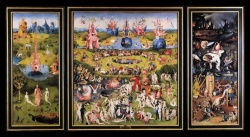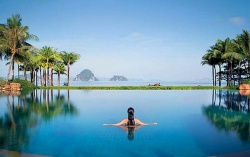Difference between revisions of "Earthly Realms"
(Created page with "thumb|250px| <poem> Manusyaloka (Tib: mi) and – This is the world of humans and human like beings who live on the surface of the earth. The mount...") |
|||
| Line 1: | Line 1: | ||
[[File:Hieronymous.jpg|thumb|250px|]] | [[File:Hieronymous.jpg|thumb|250px|]] | ||
<poem> | <poem> | ||
| − | Manusyaloka (Tib: mi) and – This is the world of humans and human like beings who live on the surface of the earth. The mountain rings that engird Sumeru are surrounded by a vast ocean, which fills most of the world. The ocean is in turn surrounded by a circular mountain wall called Cakravada (Pali: Cakkavala) which marks the horizontal limit of the world. In this ocean there are four continents which are, relatively speaking, small islands in it. Because of the immenseness of the ocean, they cannot be reached from each other by ordinary sailing vessels, although in the past, when the | + | Manusyaloka (Tib: mi) and – This is the world of humans and human like beings who live on the surface of the earth. The mountain rings that engird [[Sumeru]] are surrounded by a vast ocean, which fills most of the world. The ocean is in turn surrounded by a circular mountain wall called Cakravada (Pali: Cakkavala) which marks the horizontal limit of the world. In this ocean there are four continents which are, relatively speaking, small islands in it. Because of the immenseness of the ocean, they cannot be reached from each other by ordinary sailing vessels, although in the past, when the [[Cakravartin]] kings ruled, communication between the continents was possible by means of the treasure called the cakraratna (Pali cakkaratana), which a [[Cakravartin]] and his retinue could use to fly through the air between the continents. The four continents are: |
| − | * Jambudvipa or Jambudipa is located in the south and is the dwelling of ordinary human beings. It is said to be shaped "like a cart", or rather a blunt nosed triangle with the point facing south. (This description probably echoes the shape of the coastline of southern India.) It is 10,000 yojanas in extent (Vibhajyavada tradition) or has a perimeter of 6,000 yojanas (Sarvastivada tradition) to which can be added the southern coast of only 3 1 and frasl;2 yojanas length. The continent takes its name from a giant Jambu tree (Syzygium cumini), 100 yojanas tall, which grows in the middle of the continent. Every continent has one of these giant trees. All Buddhas appear in Jambudvipa. The people here are five to six feet tall and their length of | + | * [[Jambudvipa]] or Jambudipa is located in the south and is the dwelling of ordinary human beings. It is said to be shaped "like a cart", or rather a blunt nosed triangle with the point facing south. (This description probably echoes the shape of the coastline of southern [[India]].) It is 10,000 yojanas in extent (Vibhajyavada tradition) or has a perimeter of 6,000 yojanas (Sarvastivada tradition) to which can be added the southern coast of only 3 1 and frasl;2 yojanas length. The continent takes its name from a giant Jambu tree (Syzygium cumini), 100 yojanas tall, which grows in the middle of the continent. Every continent has one of these giant trees. All [[Buddhas]] appear in [[Jambudvipa]]. The people here are five to six feet tall and their length of [[Life]] varies between 80,000 and 10 years. |
| − | * Purvavideha or Pubbavideha is located in the east, and is shaped like a semicircle with the flat side pointing westward (i.e., towards Sumeru). It is 7,000 yojanas in extent (Vibhajyavada tradition) or has a perimeter of 6,350 yojanas of which the flat side is 2,000 yojanas long (Sarvastivada tradition). Its tree is the acacia. The people here are about 12 feet (3.7 m) tall and they live for 250 years. | + | * [[Purvavideha]] or Pubbavideha is located in the east, and is shaped like a semicircle with the flat side pointing westward (i.e., towards [[Sumeru]]). It is 7,000 yojanas in extent (Vibhajyavada tradition) or has a perimeter of 6,350 yojanas of which the flat side is 2,000 yojanas long (Sarvastivada tradition). Its tree is the acacia. The people here are about 12 feet (3.7 m) tall and they live for 250 years. |
| − | [[ | + | [[File:Ritz-Carlton.jpg|thumb|250px|]] |
* Aparagodaniya or Aparagoyana is located in the west, and is shaped like a circle with a circumference of about 7,500 yojanas (Sarvastivada tradition). The tree of this continent is a giant Kadamba tree. The human inhabitants of this continent do not live in houses but sleep on the ground. They are about 24 feet (7.3 m) tall and they live for 500 years. | * Aparagodaniya or Aparagoyana is located in the west, and is shaped like a circle with a circumference of about 7,500 yojanas (Sarvastivada tradition). The tree of this continent is a giant Kadamba tree. The human inhabitants of this continent do not live in houses but sleep on the ground. They are about 24 feet (7.3 m) tall and they live for 500 years. | ||
| − | * Uttarakuru is located in the north, and is shaped like a square. It has a perimter of 8,000 yojanas, being 2,000 yojanas on each side. This continents tree is called a kalpavrksa (Pali: kapparukkha) or kalpa tree, because it lasts for the entire kalpa. The inhabitants of Uttarakuru are said to be extraordinarily wealthy. They do not need to labor for a living, as their | + | * Uttarakuru is located in the north, and is shaped like a square. It has a perimter of 8,000 yojanas, being 2,000 yojanas on each side. This continents tree is called a kalpavrksa (Pali: kapparukkha) or kalpa tree, because it lasts for the entire kalpa. The inhabitants of Uttarakuru are said to be extraordinarily wealthy. They do not need to labor for a living, as their [[Food]] grows by itself, and they have no private property. They have cities built in the air. |
</poem> | </poem> | ||
{{R}} | {{R}} | ||
Revision as of 08:45, 21 March 2013
Manusyaloka (Tib: mi) and – This is the world of humans and human like beings who live on the surface of the earth. The mountain rings that engird Sumeru are surrounded by a vast ocean, which fills most of the world. The ocean is in turn surrounded by a circular mountain wall called Cakravada (Pali: Cakkavala) which marks the horizontal limit of the world. In this ocean there are four continents which are, relatively speaking, small islands in it. Because of the immenseness of the ocean, they cannot be reached from each other by ordinary sailing vessels, although in the past, when the Cakravartin kings ruled, communication between the continents was possible by means of the treasure called the cakraratna (Pali cakkaratana), which a Cakravartin and his retinue could use to fly through the air between the continents. The four continents are:
* Jambudvipa or Jambudipa is located in the south and is the dwelling of ordinary human beings. It is said to be shaped "like a cart", or rather a blunt nosed triangle with the point facing south. (This description probably echoes the shape of the coastline of southern India.) It is 10,000 yojanas in extent (Vibhajyavada tradition) or has a perimeter of 6,000 yojanas (Sarvastivada tradition) to which can be added the southern coast of only 3 1 and frasl;2 yojanas length. The continent takes its name from a giant Jambu tree (Syzygium cumini), 100 yojanas tall, which grows in the middle of the continent. Every continent has one of these giant trees. All Buddhas appear in Jambudvipa. The people here are five to six feet tall and their length of Life varies between 80,000 and 10 years.
* Purvavideha or Pubbavideha is located in the east, and is shaped like a semicircle with the flat side pointing westward (i.e., towards Sumeru). It is 7,000 yojanas in extent (Vibhajyavada tradition) or has a perimeter of 6,350 yojanas of which the flat side is 2,000 yojanas long (Sarvastivada tradition). Its tree is the acacia. The people here are about 12 feet (3.7 m) tall and they live for 250 years.
* Aparagodaniya or Aparagoyana is located in the west, and is shaped like a circle with a circumference of about 7,500 yojanas (Sarvastivada tradition). The tree of this continent is a giant Kadamba tree. The human inhabitants of this continent do not live in houses but sleep on the ground. They are about 24 feet (7.3 m) tall and they live for 500 years.
* Uttarakuru is located in the north, and is shaped like a square. It has a perimter of 8,000 yojanas, being 2,000 yojanas on each side. This continents tree is called a kalpavrksa (Pali: kapparukkha) or kalpa tree, because it lasts for the entire kalpa. The inhabitants of Uttarakuru are said to be extraordinarily wealthy. They do not need to labor for a living, as their Food grows by itself, and they have no private property. They have cities built in the air.

